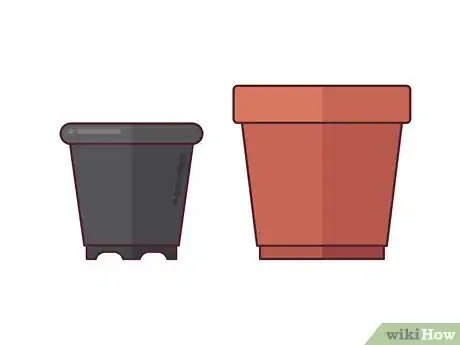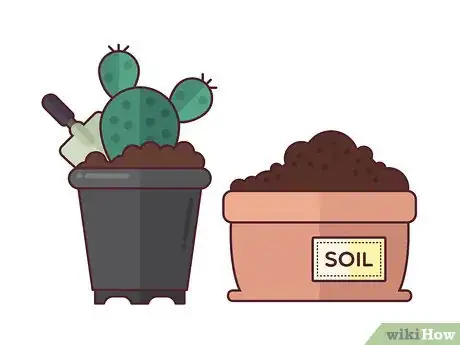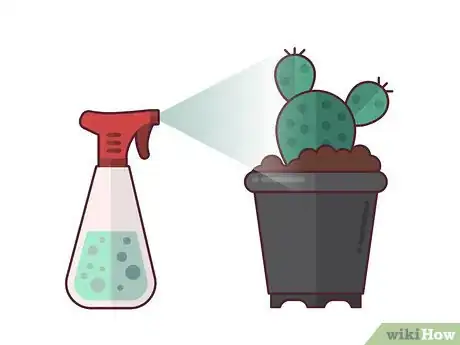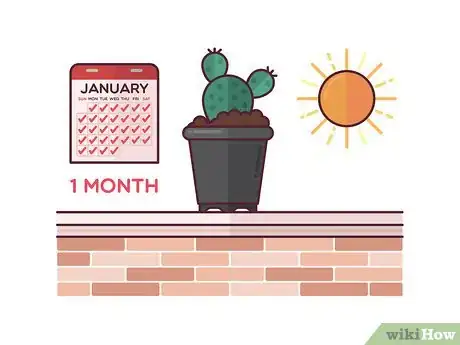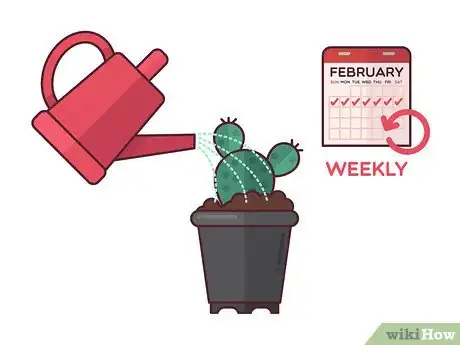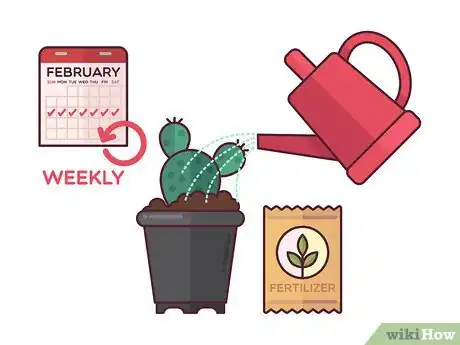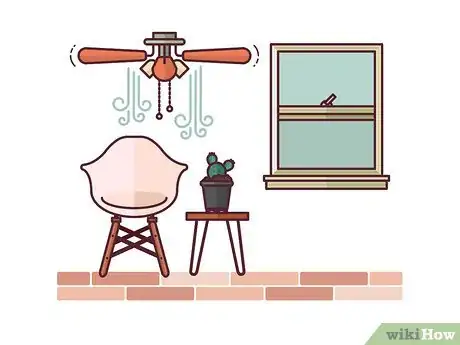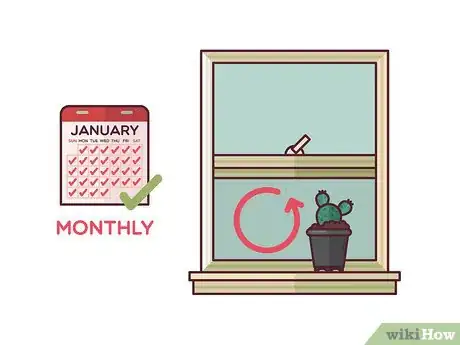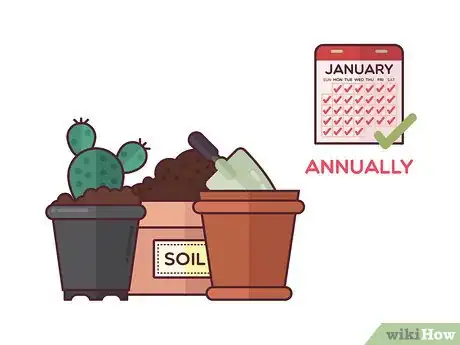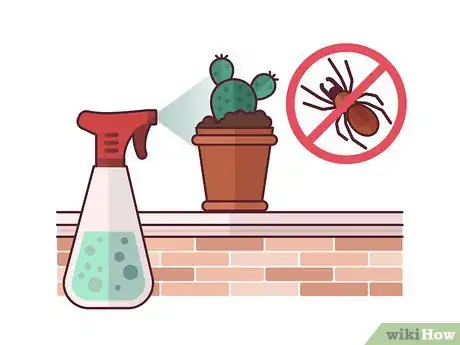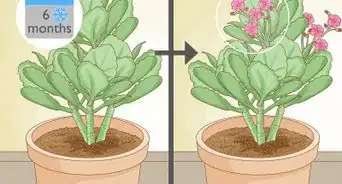This article was co-authored by Lauren Kurtz. Lauren Kurtz is a Naturalist and Horticultural Specialist. Lauren has worked for Aurora, Colorado managing the Water-Wise Garden at Aurora Municipal Center for the Water Conservation Department. She earned a BA in Environmental and Sustainability Studies from Western Michigan University in 2014.
wikiHow marks an article as reader-approved once it receives enough positive feedback. This article has 32 testimonials from our readers, earning it our reader-approved status.
This article has been viewed 744,742 times.
Cacti are typically desert-dwelling plants that thrive in dry and hot conditions, but these plants also make excellent indoor houseplants. Cacti are quite low-maintenance and need less care than many other houseplants, making them an ideal plant for new gardeners and a great housewarming gift. The secrets to growing healthy cacti indoors include providing them with plenty of sunlight, not overwatering, and using the right soil.
Steps
Propagating New Plants
-
1Take a cutting from a healthy cactus. You can grow new cacti from a pup that shoots off of a healthy mother plant. Choose a pup that’s plump, unblemished, and healthy. Gently cut or break off an entire pup from the plant.[1]
- You can also buy cacti at local nurseries, home stores, and garden centers.
-
2Let the wound heal. Transfer the cutting to a sunny windowsill. Lay the cutting down flat and leave it for about two days. This will give the wound time to form a callous. If you don’t let the wound heal before planting, the cutting will likely rot.[2]Advertisement
-
3Select a pot for the cactus. The most important thing to remember when choosing a pot for a cactus is drainage. Find a pot with drainage holes in the bottom that will allow excess water to drain out. Cacti also do well in smaller pots, so choose a pot that’s about twice the size of the plant.
- You can use clay or plastic pots for cacti. Plastic pots are lighter and cheaper, but heavier clay pots are better for large or top-heavy plants.[3]
-
4Fill the pot with a cactus-specific potting soil. Cacti need soil that drains very quickly, so choose a medium that’s specific for these types of plants. For even better drainage, mix two parts of the cactus potting soil with one part lava rock pebbles or pearlite.
- Cacti that sit in wet soil are prone to fungal and bacterial growth.[4]
-
5Plant the cutting in the soil. Place the stem or leaf cutting callous-down in the potting soil. Push the cutting in just deep enough so that it will stand up on its own. Use your hands to gently firm the soil around the cutting to stabilize it.[5]
-
6
-
7Keep the cutting in a bright location. Transfer the cutting to a windowsill or other area that gets lots of bright but indirect sunlight. Too much direct sun can damage a new cutting. Leave the cutting in this location for a month or two, until new growth starts to appear.[7]
Caring for Cacti
-
1Choose a sunny location. Once established, most species of cacti need several hours of direct sunlight every day. A south- or east-facing window will be ideal for most cacti. However, if the cactus starts to look yellowed, bleached, or orangey, it is likely getting too much light, and you should move it to a west-facing window.[8]
- Kitchen and bathroom windows are great for cacti, because they can pull additional moisture from the air as needed.[9]
-
2Water the cactus weekly during growing season. Overwatering can kill a cactus, but the plant will need weekly waterings during active growing periods. Growth phases are typically between spring and fall. When the soil feels dry to the touch, water the plant until the soil is thoroughly damp.[10]
- Don’t water if the soil is still moist, as this will cause rot and kill the plant.
-
3Fertilize the plant weekly during the growing season. Cacti will also benefit from regular feedings during the spring, summer, and fall months. When you go to water the cactus each week, stir in a balanced 10-10-10 fertilizer before watering. Dilute the fertilizer to a quarter of the strength as recommended by the label.[11]
-
4Provide plenty of circulation. Cacti don’t necessarily like drafts or stiff breezes, but they will thrive in areas where there's plenty of fresh air. You can improve the circulation in your home by running ceiling fans, opening vents, and opening windows during warmer weather.
-
5Rotate the pot monthly. Like many plants, a cactus will grow toward the light, and this can cause uneven or distorted growth. Encourage balanced growth by providing the cactus with even light, and rotate the pot a quarter turn every month.[12]
-
6Repot the cactus annually. Pick a well-draining pot that’s one size larger than the current pot. Fill the pot with cactus potting mix. Pick up your cactus, place your hand around the base of the plant, and turn the pot over to remove the cactus. Gently tap the roots to remove old soil, and prune off any dead or dried roots. Place the cactus in the new pot and firm the soil around the base with your hands.
- For the first two weeks after transplanting, don’t water the cactus, and keep it in a bright location that’s protected from direct sunlight.[13]
-
7Encourage the cactus to enter dormancy in winter. Fall and winter are typically dormant months for cacti. Dormancy is necessary for most plants to recoup their energy, and the rest period will encourage flower growth later on. You can help the plant enter dormancy by:[14]
- Cutting back watering to once a month
- Stopping the regular feedings
- Moving the cactus to a cooler window (ideally between 45 and 55 °F (7 and 13 °C)
Troubleshooting Common Problems
-
1Move the cactus to a darker location if it’s getting bleached. Some cactus varieties do better with indirect sunlight. If your cactus is turning white, yellowing, or spots are turning orange, it likely means the plant is getting too much sun. Move the cactus to a window that gets less direct sun.[15]
-
2Move the plant to a brighter location if it’s reaching or thinning. A cactus that isn't getting enough light may start to grow toward the light, causing distorted or unbalanced growth. Another symptom is a thinning top. Move the cactus to a window that gets more direct sunlight.
- To prevent scorching, move a cactus to a brighter location gradually, by moving it closer to the light over a period of a few days.
-
3Address common cactus pests. There are a few insects that can be problematic when you're growing cacti, including mealy bugs, scale, and spider mites. To get rid of these pests, rinse or mist the cactus with water to wash away the pests. Insecticides are not often useful at treating these problems.[16]
- Mealy bugs can be identified by the fuzzy patches they create on the plants, scale looks like raised brown spots, and spider mites will create whitish webs.
Expert Q&A
Did you know you can get premium answers for this article?
Unlock premium answers by supporting wikiHow
-
QuestionMy cactus splits like an over ripe tomato. What should I do?
 Lauren KurtzLauren Kurtz is a Naturalist and Horticultural Specialist. Lauren has worked for Aurora, Colorado managing the Water-Wise Garden at Aurora Municipal Center for the Water Conservation Department. She earned a BA in Environmental and Sustainability Studies from Western Michigan University in 2014.
Lauren KurtzLauren Kurtz is a Naturalist and Horticultural Specialist. Lauren has worked for Aurora, Colorado managing the Water-Wise Garden at Aurora Municipal Center for the Water Conservation Department. She earned a BA in Environmental and Sustainability Studies from Western Michigan University in 2014.
Professional Gardener
-
QuestionDo Christmas cacti have a dormancy period after they bloom? Should I put it in a dark closet?
 Lauren KurtzLauren Kurtz is a Naturalist and Horticultural Specialist. Lauren has worked for Aurora, Colorado managing the Water-Wise Garden at Aurora Municipal Center for the Water Conservation Department. She earned a BA in Environmental and Sustainability Studies from Western Michigan University in 2014.
Lauren KurtzLauren Kurtz is a Naturalist and Horticultural Specialist. Lauren has worked for Aurora, Colorado managing the Water-Wise Garden at Aurora Municipal Center for the Water Conservation Department. She earned a BA in Environmental and Sustainability Studies from Western Michigan University in 2014.
Professional Gardener
-
QuestionHow to fertilize the cactus?
 wikiHow Staff EditorThis answer was written by one of our trained team of researchers who validated it for accuracy and comprehensiveness.
wikiHow Staff EditorThis answer was written by one of our trained team of researchers who validated it for accuracy and comprehensiveness.
Staff Answer wikiHow Staff EditorStaff AnswerThe best fertilizer for your indoor cactus is a balanced one, to ensure that all the nutrients needed are provided. The ratios of nitrogen, potassium and phosphorus will depend on what you want the plant to achieve: growth (higher nitrogen ratio), more flowering (higher potassium ratio) or greater disease resistance (higher phosphorus ratio). Use liquid fertilizer, it should be at a quarter to half strength, as cacti are not heavy feeders; apply during watering when it’s the growing season. If the cactus is receiving little light indoors, do not give it too much fertilizer or it will produce weak growth.
wikiHow Staff EditorStaff AnswerThe best fertilizer for your indoor cactus is a balanced one, to ensure that all the nutrients needed are provided. The ratios of nitrogen, potassium and phosphorus will depend on what you want the plant to achieve: growth (higher nitrogen ratio), more flowering (higher potassium ratio) or greater disease resistance (higher phosphorus ratio). Use liquid fertilizer, it should be at a quarter to half strength, as cacti are not heavy feeders; apply during watering when it’s the growing season. If the cactus is receiving little light indoors, do not give it too much fertilizer or it will produce weak growth.
Warnings
- Wear gloves when handling cacti to protect yourself from the prickles.⧼thumbs_response⧽
References
- ↑ http://www.gardenersworld.com/how-to/grow-plants/how-to-take-cuttings-from-cacti-and-succulents/
- ↑ http://www.apartmenttherapy.com/how-to-propagate-cacti-succulents-apartment-therapy-tutorials-189465
- ↑ http://www.csssj.org/welcome_visitors/basic_culture.html
- ↑ https://garden.org/ideas/view/kararenee/1976/Indoor-Cactus-Gardening-101/
- ↑ https://www.youtube.com/watch?v=fqD99lmyCOs
- ↑ http://www.apartmenttherapy.com/how-to-propagate-cacti-succulents-apartment-therapy-tutorials-189465
- ↑ http://www.gardenersworld.com/how-to/grow-plants/how-to-take-cuttings-from-cacti-and-succulents/
- ↑ http://www.care2.com/greenliving/how-to-keep-your-indoor-cactus-thriving.html
- ↑ https://www.youtube.com/watch?v=fqD99lmyCOs
- ↑ http://www.care2.com/greenliving/how-to-keep-your-indoor-cactus-thriving.html
- ↑ http://www.csssj.org/welcome_visitors/basic_culture.html
- ↑ http://www.csssj.org/welcome_visitors/basic_culture.html
- ↑ http://www.csssj.org/welcome_visitors/basic_culture.html
- ↑ http://www.care2.com/greenliving/how-to-keep-your-indoor-cactus-thriving.html
- ↑ http://www.csssj.org/welcome_visitors/basic_culture.html
- ↑ https://garden.org/ideas/view/kararenee/1976/Indoor-Cactus-Gardening-101/
About This Article
To grow a cactus indoors, place it in a bright, sunny spot that gets around 8 hours of sunlight per day. If your cactus starts to turn brown or yellow, it might be getting too much direct sunlight. In that case, move it further away from the light. Water your cactus thoroughly every 10-14 days during the spring, summer, and fall. Overwatering can kill a cactus, so skip watering if the soil is damp. Only water your cactus about once a month during the winter since it will be dormant. Fertilizing your cactus once a week during the spring, summer, and fall with a 10-10-10 liquid fertilizer will help it grow. Plan on repotting your cactus once a year in a pot that's one size larger than its current pot so it continues to grow. For more from our Horticultural reviewer on growing cactus indoors, including how to propagate new cactus plants, scroll down!


